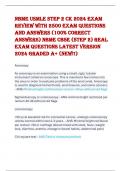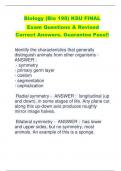NBME USMLE STEP 2 CK 2024 EXAM
REVIEW WITH 2500 EXAM QUESTIONS
AND ANSWERS (100% CORRECT
ANSWERS) NBME CBSE (STEP 2) REAL
EXAM QUESTIONS LATEST VERSION
2024 GRADED A+ (NEW!!)
Anoscopy
An anoscopy is an examination using a small, rigid, tubular
instrument called an anoscope. This is inserted a few inches into
the anus in order to evaluate problems of the anal canal. Anoscopy
is used to diagnose hemorrhoids, anal fissures, and some cancers.
- ANS-Minimal bright red blood per rectum <40 yo without red flags
Sigmoidoscopy or colonoscopy - ANS-minimal bright red blood per
rectum 40-49 without red flags
colonoscopy
>50 yo at elevated risk for colorectal cancer, undergo colonoscopy
unless normal within last 2-3 years. - ANS-Minimal bright red blood
per rectum >50 or red flags (blood mixed with stool, fever, weight
loss, diarrhea, anemia, change in bowel habits, abdominal pain)
Chi-square test - ANS-Test to compare portions
,meta-analysis - ANS-Pooling data from several studies to do an
analysis
Analysis of Variance (ANOVA) - ANS-Compare the means of three or
more variables
T-test or Z-test - ANS-Compare the means of two variables
renal ultrasound - ANS-patients with severe bladder outlet
obstruction due to BPH can develop acute kidney injury. Best next
step in evaluating AKI?
BPH (benign prostatic hyperplasia)
high postvoid residual volume
Initial evaluation should include urinalysis (exclude infection and
hematuria) and serum PSA to assess risk for prostate cancer. - ANS-
Lower urinary tract symptoms such as urinary urgency, hesitancy,
nocturia, weak urinary stream. Smooth enlarged prostate on exam.
Immobilization (direct muscle damage and release of creatinine
phosphokinase (CPK)
Cocaine (diffuse ischemia, seizures, agitation, direct toxic effect on
myocytes)
Elevated K and CPK strongly suggest Rhabdomyolysis. Leading to
Acute Tubular necrosis from excess filtered myoglobin. Significant
when CPK>20,000. Also urine dipstick will be + for blood with no
RBCs due to myoglobin in the urine
,Decrease risk of renal failure with aggressive hydration, Mannitol,
Urine Alkalinization. - ANS-strong risk factors for Rhabdomyolysis
Euthyroid state with an estrogen induced increase in T4-Binding
Globulin (TBG).
High levels of Estrogen (pregnancy, OCPs, Hormone replacement
therapy) increase TBG and therefore an elevated T4.
Also can be caused by Acute Hepatitis - ANS-Female with Elevated
T4 but Normal TSH, normal thyroid exam
Androgenic hormones, High dose glucocorticoids/hypercortisolism,
Hypoproteinemia (Nephrotic syndrome, starvation), Chronic Liver
disease. - ANS-T-4 Binding Globulin can be decreased by?
Salicylates, Furosemide, Heparin - ANS-in patients with normal
hypothalamic-pituitary feedback, displacement of T4 from its
binding proteins leads to decreased thyroid hormone perfection and
lower T4 levels with normal free hormone levels. seen as an effect
from what medications?
Grave's Disease/ hyperthyroidism - ANS-Thyrotropin-Receptor
Antibodies
-Oxygen for arterial saturation <90%
-Nitrates (caution with hypotension, RV infarct, severe aortic
stenosis)
-Antiplatatelt Therapy (Aspirin + P2Y12 receptor Blockers
(Clopidogrel, Ticagrelor))
-Anticoagulation (Unfractionated Heparin, LMWH, Bivalirudin)
-Beta Blockers (Contraindicated in HF, High risk for cariogenic
shock, Bradycardia)
, -Prompt reperfusion with PCI (<90 minutes)
-Statin ASAP - ANS-Management of STEMI
-within 12 hours of symnptoms & within 90 minutes from first
medical contact to device time at PCI capable facility
-within 120 minutes from first medical contact to non PCI capable
facility - ANS-Guidelines for Primary PCI for patients with acute
STEMI
acute pericarditis
can present in first severeal days Post MI - ANS-Sharp Pleuritic
chest pain that is worse with deep inspiration or when supine and
relieved with sitting up and leaning forward. ECG shows diffuse ST
segment elevation and PR segment Depression.
no treatment - ANS-Gallstones without Symptoms, Treatment?
Elective lap chole, or urodeoxycholic acid in poor surgical
candidates - ANS-Gallstones with typical biliary colic symptoms,
treatment?
Cholesystectomy within 72 hours - ANS-Complicated gallstone
disease (Acute Cholecystitis, Choledocholithiasis, Gallstone
pancreatitis)
Slipped Capital Femoral Epiphysis
requires immediate surgical screw fixation to reduce risk of AVN -
ANS-Obese Child
with dull hip PAIN or referred knee pain and a painful limp
with restricted ROM and inability to bear weight
on exam has limited rotation and abduction of the hip





